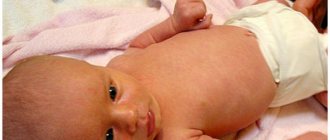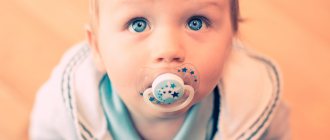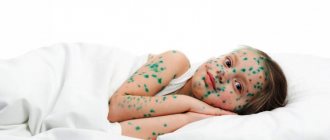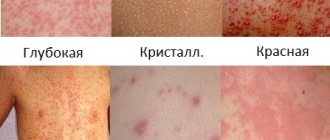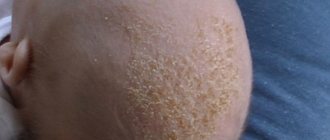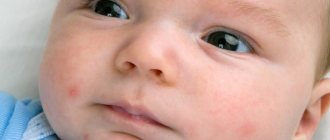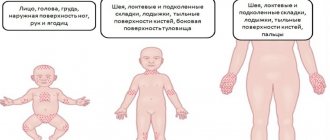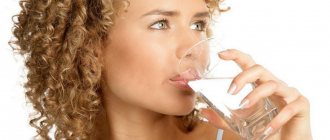Small pimples broke out on baby
Rashes on the face and body of newborns are not a disaster.
In fact, almost every second parent faces this problem. And sometimes a rash is a variant of the norm. In particular, small pimples in a baby can be:
- Milia, or small whiteheads (usually found on the nose and chin).
- Erythema toxicum - yellowish-white pimples with a reddish ring.
- Prickly heat.
- Red pimples and pustules, like teenagers.
- Allergic rashes (most often found on the cheeks).
- Manifestations of dermatitis.
The listed causes of acne are quite harmless; they do not pose a direct threat to the child. But sometimes a rash becomes a symptom of infectious diseases and other serious conditions.
Rashes should be dealt with correctly. The child should be shown to a doctor so as not to confuse acne with an allergy or a manifestation of an infectious disease.
A temporary phenomenon that goes away on its own without special therapy.
Medicinal ointments and a strict mother’s diet will help with allergic rashes. It is important to determine the source of the allergen. If it is a plant, it needs to be removed from the nursery. The baby's clothes are washed with baby powders, the room is ventilated, and regular wet cleaning is done without using chlorine-containing detergents.
When treating prickly heat, babies are bathed in herbal decoctions of string, chamomile, and calendula. Afterwards, dry the skin with a diaper and sprinkle with talcum powder. An excellent method of treatment is air baths.
Treatment is under the supervision of a specialist. High temperatures are brought down with antipyretic drugs and medications prescribed by the doctor are used. These are bacterial ointments, Kalanchoe or rosehip oil, camphor alcohol. Purulent pimples are lubricated with chlorophyllipt. Bathing is temporarily stopped. The affected areas of the body are treated with zinc ointments, the baby is dressed in clothes made from natural fabrics, and the use of wet wipes and disposable diapers is avoided.
If the child’s condition worsens, he is placed in a hospital, where antibiotic therapy is administered, sulfonamides and vitamin injections are prescribed. Ultraviolet irradiation can help the baby. A timely visit to a doctor will help identify the disease and completely eliminate its symptoms in the form of ulcers.
Preventive measures
Prevention consists of quality care for the newborn. Wash your face only with boiled water at a comfortable temperature and twice a day. Bed linen and baby clothes are washed only with hypoallergenic products intended for children. After washing, iron everything. Children's clothes should only be made of cotton or flannelette fabric. It is recommended to give the baby air baths, if possible in the fresh air. However, you should not keep your child in direct sunlight.
It is very useful to add decoctions of medicinal herbs to the water when bathing the baby. This perfectly tones the skin and disinfects it. When using disposable diapers, they are changed at least 4-5 times a day. The butt is washed, dried and the skin is allowed to breathe for about half an hour. Pediatricians recommend taking off diapers at home and putting them on only when going for a walk or to visit the doctor. All toys are periodically washed with boiled hot water without adding detergents. Damage to the baby's skin should be treated with hydrogen peroxide. Regular visits to the doctor will help avoid many problems associated with rashes.
What not to do during treatment
At home, you can help a newborn by washing him with boiled water, bathing him in a weak solution of potassium permanganate, a decoction of string and calendula. You need to carefully monitor your baby's skin to prevent new acne from appearing.
- use alcohol-containing lotions, sprays, solutions. They will not cure the baby, but will burn his sensitive skin;
- use fatty oils, ointments and creams;
- apply hormonal ointment to the child’s skin without a doctor’s prescription;
- give your baby antibiotics, probiotics, adsorbents, antihistamines without a doctor’s instructions;
- squeeze out pimples or poke them with a needle.
How to treat pustules?
If purulent acne appears due to the active functioning of the sebaceous glands or hormonal imbalances, the baby must be thoroughly cared for. In the morning and evening, the baby’s face should be washed with warm boiled water. When bathing a child, potassium permanganate is added to the water, which disinfects the skin and kills pathogenic bacteria. At the end of the procedure, the skin is delicately blotted with a soft towel, and pimples are lubricated with decoctions of string, calendula or chamomile.
If neoplasms are detected on the skin of a baby, you should consult a doctor who will prescribe a suitable ointment.
If you suspect a pathological cause for the rash, you need to consult a doctor who will prescribe antibacterial ointments suitable for infants. You can smear the pimples with sea buckthorn or Kalanchoe oil, aloe or plantain juice. Ulcers should be treated with chlorophyllipt or a solution of brilliant green. If acne does not go away, you should stop bathing and lubricate the rash with zinc ointment. For pimples on the buttocks of a newborn, diapers are abandoned so that the skin on the bottom can breathe. If it is necessary to open an abscess, it is carried out exclusively in stationary conditions. In the hospital, the child is treated with antibiotics, vitamin injections, and sulfonamides.
Children's pimples should not be squeezed or treated with alcohol or creams.
Face, head and back
If ulcers suddenly appear on the body, their causes and treatment can be completely different.
For example, on the face they arise due to the fact that the sebaceous ducts of the skin are clogged with subcutaneous fat.
In this case, pus is a product that appears after decay.
Those who have had such acne note that they are extremely painful.
They appear suddenly and grow from small, barely visible lumps. The result is a large blackhead that has a core of pus in the center.
Ulcers on the head are always accompanied by itching, discomfort when scratching, as well as peeling. Such formations appear due to the fact that the hair retains heat from.
In addition, fat production is associated with this condition. All this creates good soil for bacteria to multiply and penetrate the skin on the head.
Pimples on the surface of the back look like red inflammation. Essentially, these are edematous tissues, under which there is purulent content. Abscesses on the back have their own varieties:
- Reddish balls called papules. They represent the mildest form of such inflammation.
- Balls with purulent contents and red color are called pustules.
- Nodes - in which the inflammatory process affects the deep layers of the skin.
- , which give strong pain when touched, are called cysts. This inflammation has a bluish tint.
- Around the lips and on intimate parts of the body.
Pimples on the lips appear when bacteria enter the pores of the skin. They are not very large in size and white in color.
If the abscesses are fully mature, then their head is clearly visible. The reasons for the occurrence of these formations may be as follows:
- The skin was taken care of incorrectly or insufficiently (for example, a cream was used that was not suitable for its type).
- The habit of holding a pencil or pen in the mouth. These items can be very dirty.
- Using expired cosmetics. This also includes products with low quality.
- Poor compliance with hygiene rules. This refers to the frequent habit of some people to touch the area with dirty hands.
Acne on intimate places can be of different types. They can be serious, for example, with venereal or skin diseases, or completely harmless, which appear during puberty.
A few weeks, more often 1 month after birth, acne may appear on the baby’s skin. The reason for their occurrence lies in the stabilization and formation of hormonal levels. Such rashes do not require any targeted treatment, but during the period of their appearance, parents need to take especially careful care of the baby’s skin:
- Avoid using fatty oils.
- Bath in a weak solution of potassium permanganate or add infusions of medicinal herbs, such as chamomile or string, to the bath.
- Do not allow the child to overheat.
- Arrange regular air baths.
Sometimes pimples on the cheeks of a child at one month of age, which are combined with redness and roughness of the skin, are the first manifestations of atopic dermatitis. This is a chronic disease that requires timely diagnosis and constant supportive therapy under the supervision of a qualified physician.
Symptoms
Parents often confuse a boil on a child’s body with an ordinary pimple, and this becomes a total mistake. Thinking that this is a minor abscess that goes away on its own, they do not treat it in any way. The result is all sorts of complications, even... Therefore, it is so important to suspect in time that this is a boil, based on the following characteristic symptoms:
- the appearance of a single pustule on the skin: it rises above the skin, is distinguished by a bright red halo around a dense and edematous abscess, where a core forms;
- after 3-4 days, a white dot forms at the top of the abscess (there is pus under the thin film);
- a boil is a very painful neoplasm;
- in this place the child feels unpleasant tingling and itching;
- it can occur in any part of the body where there is hair;
- enlargement of nearby lymph nodes due to the inflammatory process;
- temperature can rise to 39°C;
- the child becomes lethargic, capricious, sleeps poorly, and refuses to eat.
The entire process from the beginning of the formation of an abscess to its complete disappearance takes about 10 days. It includes several stages:
- Infiltration. Formation of painful compaction, swelling.
- Suppuration, necrosis. The infection is activated, intoxication occurs, and a core is formed.
- Recovery, healing. Formation of granulation tissue and scar. Blue and pale discoloration of inflamed tissue.
The main difference between a boil and a pimple is a long period of ripening and extreme pain. It is not always able to pass on its own. To alleviate the child’s condition, he should be shown to a doctor and, if necessary, undergo a course of treatment, but only after appropriate diagnosis.
A rash in infants appears for various reasons; it can be a symptom of a serious infectious disease, allergy, or a sign of hormonal changes in the body. Only a highly qualified pediatric dermatologist can accurately determine the nature of the rash, so it is better not to delay a visit to the doctor.

